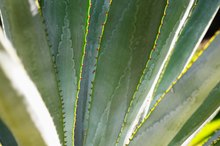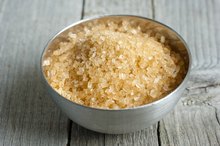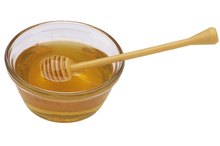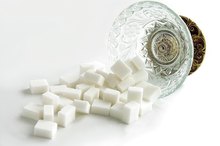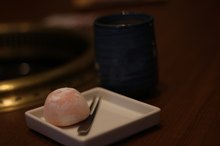Foods High in Glycolic Acid
Glycolic acid is a colorless, odorless, crystalline substance that when combined with water is a highly effective cosmetic skin exfoliator and moisturizer. Derived from sugarcane, glycolic acid is a natural substance typically used for dermatological and industrial purposes. One benefit of glycolic acid in your diet is that it’s gluten free, which means that people with allergies and sensitivity to wheat products can use this ingredient as a sweetening substitute.
Sugarcane
A common source of glycolic acid is sugarcane, according to the book Cosmetic Dermatology by Cheryl M. Burgess 1. Sugarcane is a type of tall grass native to temperate and tropical climates. The main uses of sugarcane are as refined sugar, molasses, rum and a type of syrup used as flavoring. The juice evaporated from cane is considered a healthy alternative to refined sugar because it is not processed to the same extent. Sugarcane may be used in cooking as sugar. It is also sold as milled cane sugar, dried cane juice and crystallized cane juice. In other countries it’s identified as unrefined sugar.
- A common source of glycolic acid is sugarcane, according to the book Cosmetic Dermatology by Cheryl M. Burgess 1.
- The juice evaporated from cane is considered a healthy alternative to refined sugar because it is not processed to the same extent.
Sugar Beets
Sources of Sucrose Sugar
Learn More
Sugar beets are a root plant harvested to produce sucrose for commercial sugar production. Popular in Germany, sugar beet syrup is used as a sandwich spread, sauce sweetener and added to cake and dessert recipes. Other cultures infuse rum with sugar beet sucrose. Sugar beets are also a good source of glycolic acid, according to Patientsguide.com. Boiling shredded beets for several hours, then pressing the mash until you’ve extracted a liquid resembling the consistency of honey, produces the syrup.
- Sugar beets are a root plant harvested to produce sucrose for commercial sugar production.
- Other cultures infuse rum with sugar beet sucrose.
Fruit
Unripe grapes, cantaloupes and pineapples contain glycolic acid, according to a report from Unionhairandskin.com. Interestingly, the glycolic acid extracted from fruit sources are used more for flavoring and preserving other foods rather than providing any dietetic benefit. One expert from the British Society of Gastroenterology indicates that consumption of pure glycolic acid can cause vomiting, gastritis and possibly even breathing problems.
Related Articles
References
- Cosmetic Dermatology: Cheryl M. Burgess
- National Institutes of Health PubChem. Glycolic acid. Updated February 1, 2020.
- Tang SC, Yang JH. Dual effects of alpha-hydroxy acids on the skin. Molecules. 2018;23(4):863. doi:10.3390/molecules23040863
- Fabbrocini G, Annunziata MC, D'Arco V, et al. Acne scars: pathogenesis, classification and treatment. Dermatol Res Pract. 2010;2010:893080. doi:10.1155/2010/893080
- U.S. Food and Drug Administration. Alpha hydroxy acids. Updated May 7, 2019.
- Al-Talib H, Al-Khateeb A, Hameed A, Murugaiah C. Efficacy and safety of superficial chemical peeling in treatment of active acne vulgaris. An Bras Dermatol. 2017;92(2):212–216. doi:10.1590/abd1806-4841.20175273
- Abels C, Reich H, Knie U, Werdier D, Lemmnitz G. Significant improvement in mild acne following a twice daily application for 6 weeks of an acidic cleansing product (pH 4). Journal of Cosmetic Dermatology. 2014;13(2):103-8. doi:0.1111/jocd.12086
- Kaminaka C, Uede M, Matsunaka H, Furukawa F, Yamomoto Y. Clinical evaluation of glycolic acid chemical peeling in patients with acne vulgaris: a randomized, double-blind, placebo-controlled, split-face comparative study. Dermatological Surgery. 2014;40(3):314-22. doi:10.1111/dsu.12417
- Sharad J. Glycolic acid peel therapy - a current review. Clinical Cosmetic and Investigational Dermatology. 2013;6:281-8. doi:10.2147/CCID.S34029
- Takenaka Y, Hayashi N, Takeda M, Ashikaga S, Kawashima M. Glycolic acid chemical peeling improves inflammatory acne eruptions through its inhibitory and bactericidal effects on Propionibacterium acnes. Journal of Dermatology. 2012;39(4):350-4. doi:10.1111/j.1346-8138.2011.01321.x
Writer Bio
Shannon Marks started her journalism career in 1994. She was a reporter at the "Beachcomber" in Rehoboth Beach, Del., and contributed to "Philadelphia Weekly." Marks also served as a research editor, reporter and contributing writer at lifestyle, travel and entertainment magazines in New York City. She holds a Bachelor of Arts in literature from Temple University.


